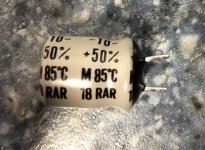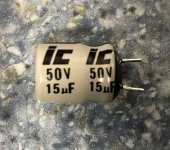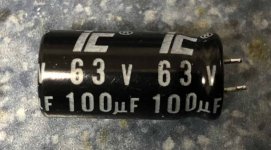I'm replacing capacitors in a 30+ year old preamp. Are these just garden variety caps, meaning simply match values and match or exceed temp & voltage ratings?
Thanks!
Thanks!
Attachments
IC is Illinois Capacitor, which is a "garden variety" brand of cap. SO it appears your unit is built with such. So modern garden variety parts ought to restore original levels of performance.
Thanks for the replies, yeah, I already had to cancel & reorder because I neglected to check lead spacing. Luckily Mouser is running behind.
I don't like doing the job over & over. Now that newark will take a debit card from individuals, I buy caps with >3000 hours service life. Store shelf stock caps had to be replaced 4 times in one amp.
Newark & digikey will show service life in the selector table. Mouser makes you download the datasheet and read it. Not all caps on the datasheet have the same life rating.
If any of those caps, as the 15 uf one, are timing caps, you'll have to parallel modern sizes to achieve that. 10 uf + 4.7 uf. Timing caps are in tone control circuits. Coupler caps, just go large.
Newark & digikey will show service life in the selector table. Mouser makes you download the datasheet and read it. Not all caps on the datasheet have the same life rating.
If any of those caps, as the 15 uf one, are timing caps, you'll have to parallel modern sizes to achieve that. 10 uf + 4.7 uf. Timing caps are in tone control circuits. Coupler caps, just go large.
... Asking myself : but the filtering caps after the diodes bridges, most of the others caps should be still ok ??? 30 years ago we were in the 90s' and technically, caps were good enough not like in the 70s' ?
Yu have to know a little about what you are changing, so the areas where yu swap on the pcb : for instance, the main power caps after the rectifier bridge maybe 105°c because this is here they suffer the most... but it doesn't mean maybe both 105°c and low ESR as are some modern caps like the Panasonic for instance. Coul be for example a 105°c long life with not a sota EST which is not a bad idea there... depends about follow next : CRC or not, and so on.
The better if you can is to show your circuitry in the amp section to get some help and/or to look for if you can the datasheets of the former caps (can be quite difficult before the XXI century)
Yu have to know a little about what you are changing, so the areas where yu swap on the pcb : for instance, the main power caps after the rectifier bridge maybe 105°c because this is here they suffer the most... but it doesn't mean maybe both 105°c and low ESR as are some modern caps like the Panasonic for instance. Coul be for example a 105°c long life with not a sota EST which is not a bad idea there... depends about follow next : CRC or not, and so on.
The better if you can is to show your circuitry in the amp section to get some help and/or to look for if you can the datasheets of the former caps (can be quite difficult before the XXI century)
- Home
- Design & Build
- Parts
- Selecting Replacement Caps



